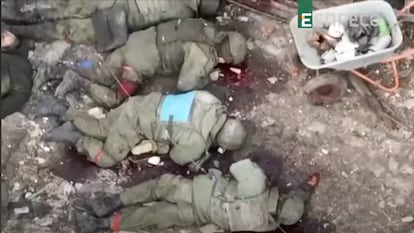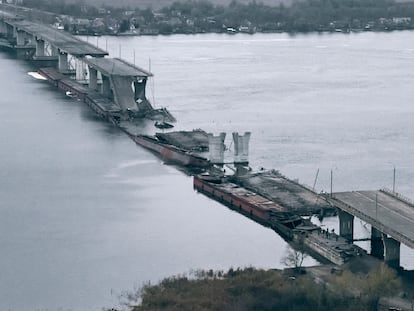Ukraine under international pressure to investigate alleged executions of Russian soldiers
The UN has confirmed it will probe the incident, in which 10 Kremlin troops were killed, and has called on Kyiv to do likewise after field report cites possible war crimes on both sides
The Armed Forces of Ukraine High Command has been compromised by allegations of a war crime carried out by its troops. Four videos filmed by Ukrainian units and subsequently distributed by pro-Kremlin media outlets appear to show the possible assassination of 10 Russian soldiers on the Luhansk front. Ukraine’s Commissioner for Human Rights Dmytro Lubinets stated his belief last weekend that the footage was staged by Moscow, but the United Nations Human Rights Office (OHCHR) has confirmed that it will investigate the incident and has called upon the authorities in Kyiv to do the same.
The events in question took place on an unspecified date in November, during the Ukrainian advance in the Luhansk province in the east of the country. In the footage, a platoon of Ukrainian infantry is seen surrounding 11 Russian soldiers at a farm in the village of Makiivka. The Ukrainian soldiers filmed part of what occurred on a cellphone. There is also some video of the incident taken by a drone: a large number of Ukrainian front-line units, above all artillery batteries, use small drones for reconnaissance. In the footage, the platoon is seen approaching the building when 10 Russian soldiers emerge with their hands in the air. They are ordered to lie face down on the ground and comply. Suddenly, another Russian soldier rushes out of the farmhouse and opens fire on the Ukrainian troops before being gunned down, according to the images captured by the drone.
After an indeterminate length of time, the drone took more footage of the Russian soldiers who had seemingly surrendered lying dead on the ground. The bodies, which were situated almost exactly where they had been when they had previously been filmed alive, were surrounded by pools of blood and some of the Russian troops displayed wounds that appeared to have been caused by ammunition from a larger caliber weapon than an assault rifle. As the Ukrainian unit moves around the front of the farmhouse, the drone footage shows them being covered by a soldier pointing a heavy-caliber PK general-purpose machine gun at the Russian troops.
On Sunday, The New York Times published an analysis of the videos and confirmed their authenticity, while several war crimes experts consulted by the US publication said that more information was needed regarding the circumstances in which the Russian soldiers were killed. According to the Rome Statute of the International Criminal Court, it would be considered a war crime if the Russian soldiers had surrendered and laid down their weapons.
Lubinets stated that the Russian unit were feigning surrender in order to open fire on the Ukrainian platoon. “The Russian servicemen could not be considered as prisoners of war, but as fighters committing treason,” he said. Moscow has accused the Ukrainian troops of committing a war crime.
The OHCHR confirmed to Reuters and France Presse that it is investigating the incident. Olga Stefanishina, Ukraine’s deputy prime minister for European and Euro-Atlantic integration, told the Associated Press on Sunday that Kyiv would also carry out an investigation, although she ruled out summary executions or possible war crimes on the part of the Ukrainian unit. In a statement sent to the same agency, the UN Mission for Human Rights in Ukraine requested the Ukrainian authorities investigate the events “with immediate effect.”
Washington is also observing the case. “We are obviously tracking that quite closely,” Beth Van Schaack, US ambassador for global criminal justice, said Monday in a telephone briefing with journalists as reported by Reuters. “It’s really important to emphasize that the laws of war apply to all parties equally: both the aggressor state and the defender state and this is in equal measure,” she said, adding: “All parties to the conflict must abide by international law or face the consequences.” Van Schaack also stated that the scale of unlawful actions among Russian forces is “enormous” in comparison to allegations leveled against Ukrainian troops. “Russia inevitably responds with propaganda, denial, mis- and dis-information, whereas Ukrainian authorities have generally acknowledged abuses and have denounced them and have pledged to investigate them,” she said.
Criminal acts on both sides of Ukraine war
The majority of accusations of the laws governing war and human rights being violated in Ukraine have fallen on Russia. United Nations investigators have confirmed that Russian forces have committed multiple war crimes against Ukrainian troops and civilians. Early fieldwork conducted by the UN in February and March and presented to the United Nations Human Rights Office in October concluded that “the impact of these violations on the civilian population in Ukraine is immense. The loss of lives is in the thousands. The destruction of infrastructure is devastating.”
The European Commission has described Russia’s attacks on civilian infrastructure in Ukraine, which has left millions of people without access to basic services such as water and heating, as a war crime. “Russian armed forces are responsible for the vast majority of the violations identified, including war crimes. Ukrainian forces have also committed international humanitarian law violations in some cases, including two incidents that qualify as war crimes,” the OHCHR report stated.
Matilda Bogner, head of the UN Mission for Human Rights in Ukraine, presented a report last week which concluded both sides had tortured prisoners of war. All the interviews conducted with captured soldiers took place in Ukrainian-controlled territory, as Russia denied the UN access to their detention centers. On the Russian side, the mistreatment of prisoners of war appears to be systematic, according to testimonies collected by the agency. On the Ukrainian side, according to Bogner, her team received “solid allegations of summary executions of soldiers hors de combat, and several cases of torture and ill-treatment committed by members of the Ukrainian Armed Forces.”
Both Ukrainian public opinion and the authorities in Kyiv have reacted belligerently to any criticism from their allies and human rights organizations. Amnesty International suffered a smear campaign in Ukraine after it published a report last August warning that the Armed Forces of Ukraine were putting non-combatants at risk in areas close to the front lines by deploying units near buildings and facilities occupied by civilians.
EL PAÍS has been able to confirm that it is not unusual for troops to sleep in residential buildings with civilians, to avoid the risks posed by bedding down in barracks. The OHCHR report also makes mention of this practice: “There are also examples of both parties to the armed conflict, although to different degrees, failing to protect civilians or civilian objects against the effects of attacks, by locating military objects and forces within or near densely populated areas.”
A few weeks before its controversial report, Amnesty International published an investigation accusing Russia of killing hundreds of civilians in Kharkiv in bombardments using prohibited weapons.
Another instance of a possible war crime that has been dismissed by Kyiv took place in March in the village of Mala Rohan, in Kharkiv province, where a video showed three Russian prisoners of war being shot in the legs after they had been taken prisoner. Both the UNHCR and the Organization for Security and Co-operation in Europe consider these facts to be true.
Moreover, the Ukrainian security forces have not been overly transparent about the prosecution of Russian collaborators. In the city of Kherson, liberated on November 11 after more than eight months of Russian occupation, testimonies collected last week by EL PAÍS indicate that arrests of possible collaborators are carried out on a daily basis and that extrajudicial executions are also being carried out. Over the last few days, images have emerged of handcuffed people in Kherson being displayed for public scorn, accused of having worked for the enemy. Many collaborators are suspected of having provided information to the Russian army about people who have disappeared.
Even so, most of the cases of documented abuse during the war have been committed by Russian forces. The Ukrainian Interior Ministry has said it is investigating around 500 cases of human rights violations committed by the occupying forces in Kherson, ranging from torture – including of minors – to summary executions and disappearances. The Ukrainian Prosecutor’s Office confirmed on Monday that four buildings used by Russian forces to torture civilians have been identified in Kherson.
Sign up for our weekly newsletter to get more English-language news coverage from EL PAÍS USA Edition.
Tu suscripción se está usando en otro dispositivo
¿Quieres añadir otro usuario a tu suscripción?
Si continúas leyendo en este dispositivo, no se podrá leer en el otro.
FlechaTu suscripción se está usando en otro dispositivo y solo puedes acceder a EL PAÍS desde un dispositivo a la vez.
Si quieres compartir tu cuenta, cambia tu suscripción a la modalidad Premium, así podrás añadir otro usuario. Cada uno accederá con su propia cuenta de email, lo que os permitirá personalizar vuestra experiencia en EL PAÍS.
¿Tienes una suscripción de empresa? Accede aquí para contratar más cuentas.
En el caso de no saber quién está usando tu cuenta, te recomendamos cambiar tu contraseña aquí.
Si decides continuar compartiendo tu cuenta, este mensaje se mostrará en tu dispositivo y en el de la otra persona que está usando tu cuenta de forma indefinida, afectando a tu experiencia de lectura. Puedes consultar aquí los términos y condiciones de la suscripción digital.
More information
Archived In
Últimas noticias
There is as much life left to discover on planet Earth as that which is already known
Dozens presumed dead, around 100 injured in fire at Swiss Alps bar during New Year’s celebration
Is porn for women different from conventional porn? We spoke to those who make it
Cartagena de Indias is sinking: What can the city do to mitigate it?
Most viewed
- Sinaloa Cartel war is taking its toll on Los Chapitos
- Reinhard Genzel, Nobel laureate in physics: ‘One-minute videos will never give you the truth’
- Oona Chaplin: ‘I told James Cameron that I was living in a treehouse and starting a permaculture project with a friend’
- David King, chemist: ‘There are scientists studying how to cool the planet; nobody should stop these experiments from happening’
- Why the price of coffee has skyrocketed: from Brazilian plantations to specialty coffee houses











































